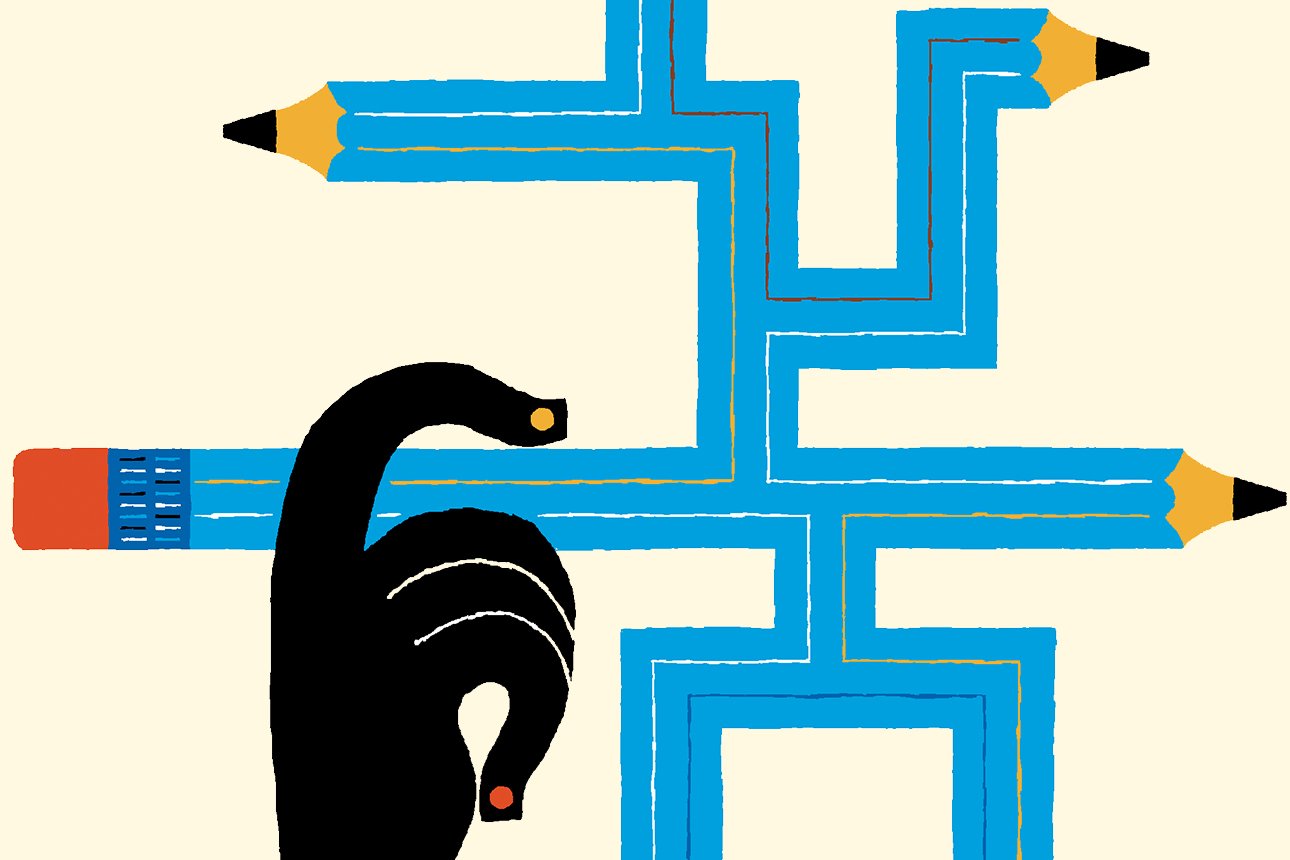Plotting Strategy in a Dynamic World
Companies can no longer rely on traditional forecasting exercises to spot — and capitalize on — emerging threats and opportunities.

Image courtesy of Adam McCauley/theispot.com
To remain competitive over time, a company must be able to move quickly in response to major changes in society, technology, competition, regulation, labor markets, and myriad other areas. Yet the possibility of such changes creates deep uncertainty, making it challenging to identify the most profitable path forward. Although organizations can never be fully prepared for an unanticipated shock, the most resilient ones learn to expect the unexpected, rebound quickly when it occurs, and take advantage of unforeseen opportunities that emerge.
To help with those efforts, we have developed a framework that goes beyond traditional forecasting and risk-assessment exercises. It consists of four sets of activities: First, develop a comprehensive set of processes to actively sense new insights (whether internal or external) that could affect the business, and hence identify threats or opportunities as early as possible. Second, organize in response to those threats or opportunities; this is likely to involve reallocating resources, revamping processes, filling capability gaps, and aligning the company’s structure and governance. Third, capture value by revising business models and restructuring relationships with other players in various ecosystems. And fourth, renew the organizational capabilities needed to create and capture value by continuing to monitor and assess results and making small adjustments over time — while also preparing for the major disruptions that require a more comprehensive overhaul.
This approach is based on the principle of dynamic capabilities, which holds that companies need to continually adapt their resources to respond to rapidly changing and unpredictable environments. Dynamic-capabilities-based models are the subject of a large and growing body of strategic management literature.1 Our framework synthesizes key lessons from this literature and provides a way forward for managers to revitalize their company’s processes, structures, and business models — and to compete effectively — in a highly dynamic business environment.
The Shifting Innovation Economy
A few decades ago, companies could build a strong business model and apply it more or less unchanged for years. In that era, resilience was based on stability and competitive barriers to entry. Consider that, in the early 1970s, nearly 80% of the most profitable publicly traded companies remained in the top quartile of performance for at least six years out of the previous 10. Today, that is no longer true, as relentless innovation and disruption threaten established business models, leading to far greater churn among top performers in virtually all industries.2 Resilience now depends on rapid and effective adaptation to change.
Nokia is a good example of how change and unexpected competition can upend even highly successful businesses. Founded in Finland in 1865 as a paper mill, the company later diversified and eventually became one of Europe’s leading electronics companies in the 1970s. It introduced its first mobile phone in 1987, and by the end of the 1990s it had become the largest cellphone manufacturer in the world. But the company was overtaken by new competition from Apple’s iPhone and Google’s Android mobile operating system. By 2016, Nokia was out of the phone business altogether — an extremely rapid reversal for a market leader. Today, it is a much smaller company selling telecom infrastructure equipment.
Contrast that with Netflix, which anticipated a large shift in technology and was thus able to adjust its strategy to capitalize on it. In the early 2000s, Netflix founder and CEO Reed Hastings committed resources at the exclusively DVD-by-mail company to build a streaming service — well before home internet services had sufficient bandwidth to support it. Netflix first offered streaming in 2007 as a free bonus to DVD renters and then, in 2011, separated the DVD and streaming offerings. Mail-order subscribers left in droves, yet it was the right realignment in response to changes in how people consumed media. And it led to tremendous success for Netflix — its streaming business grew from 10 million subscribers in 2010 to over 160 million in 2020.
A Framework for Strategic Resilience
Making such prescient moves requires a structured way of looking out over the horizon and anticipating what’s coming. Drawing on the rich vein of dynamic-capabilities thinking, we propose the following model.
1. Sense. Management teams can’t respond to a problem if they haven’t figured out that it exists — nor can they capitalize on new opportunities they have yet to recognize. Although most organizations have some sensing activities in place, they often lack a systematic approach to gathering and sharing critical information. To successfully anticipate change, organizations must be designed for, and become accustomed to, gathering and sharing information from a wide range of sources, such as current and former customers, strategic partners, internal R&D staff, customer-facing employees, suppliers, local and regional stakeholders, university labs, boards of directors and advisers, trade media, and current and anticipated competitors. Big data and machine learning techniques can be used to tease out insights from combinations of the internal and external data streams.
One of the biggest challenges is getting information to the right places in the organization. Therefore, organizational design must foster the free flow of information from gathering points to wherever it may be relevant — for example, by ensuring that visible processes and incentive systems encourage collaboration and interaction.3 And when the future is particularly hard to read, leaders must distill insights by creating a range of scenarios and then developing, testing, and retesting hypotheses.4
These principles of sensing can be seen in action at Progressive, one of the largest auto insurers in the U.S. Progressive offers customers a mobile app called Snapshot that allows the company to capture billions of miles of driving data so it can provide finely segmented, usage-based rates. It combines that information with data from the marketing, claims, and policy service departments in a repository that can be accessed by analysts and managers throughout the organization via a dashboard.5 Progressive also created the Business Innovation Garage, a secure space where any employee can rapidly prototype and test new offerings.
2. Organize. Leaders also need to build flexible structures and processes that enable the organization to innovate and embrace change. A key aspect of organizing is filling capability gaps that arise when a company enters a new market or revamps its business model.
In the mid-1990s, Samsung committed to building a capability in industrial design — an effort that took several years and included opening a multidisciplinary in-house design institute along with design bureaus in Europe, the U.S., and Japan.6 To maintain flexibility as products are developed, Samsung often has multiple design and engineering teams working on similar products and eventually launches the ones that are best suited to current market conditions. Samsung’s intentionally developed design capability and its skill at reallocating resources where needed were critical to the company’s expansion into smartphones from its traditional base in home appliances and consumer electronics. Despite a slow start in the smartphone sector (Samsung’s first Android-based devices debuted in mid-2010, three years after Apple launched the iPhone), the company quickly grew to dominate the worldwide smartphone market.
The best approach to organizing will vary depending on a company’s circumstances, but several principles are widely applicable. For example, companies can often become more responsive and innovative by flattening management hierarchies and decentralizing decision-making authority. However, when they decentralize, they need to find ways to keep people moving toward shared goals to prevent chaos.7 A company’s culture — including its mission, values, and management style — can provide that sense of direction. But that culture should be entrepreneurial rather than bureaucratic — for example, ensuring that small, early failures lead to learning rather than blaming.8 As we’ve seen time and again, the most innovative organizations also are open to thoughtful criticism that forces the holders of the consensus view to sharpen (or, in some cases, abandon) their thinking.9
3. Capture. Capturing value requires leaders to execute strategic priorities by orchestrating their company’s tangible and intangible assets — such as capital, strategic partnerships, and intellectual property — as well as making changes to business models as required. Amazon, for example, developed proprietary technology infrastructure to enable its unprecedented scale advantage over competing online retailers. It subsequently leveraged that very IT architecture in order to create a highly profitable cloud computing business, an operation that now funds many of its other strategic initiatives.
Maximizing value capture also entails determining which activities can safely be outsourced and which ones must be retained in-house because they are critical to a company’s product road map or value delivery system (or both).10 Finally, operating discipline is an important contributor to capturing and retaining value in the enterprise. Management must define clear priorities and objectives, along with metrics to gauge progress.
4. Renew. Sensing activities will inevitably call the wider status quo into question and will sometimes even require that companies overhaul their entire identity.11 Yet for each of the successful renewals mentioned above, many other companies have failed to see themselves and their situations with fresh eyes, including Kodak, Blockbuster, and Yahoo, to name just a few. Top management must not be afraid to revise or ditch an assumption in light of new evidence, as difficult as that can be. As Ron Heifetz of Harvard’s Kennedy School of Government pointed out, “Mustering the courage to interrogate reality is a central function of a leader.”12
Renewal is best seen as a continuous endeavor. Between major transitions, there is often value in “tuning up” the company’s culture, organization, and routines. That includes considering changes to incentive systems, reporting structures, decision-making, and business processes.
Moreover, as these changes are made, they generate new data. Leaders must use that information to gauge the accuracy of any assumptions that went into their strategic planning and adjust accordingly.13 In that sense, this fourth component of the framework includes continually assessing results and revising the first three components.
Fluid Timing
The four sets of activities and capabilities defined above — sensing, organizing, capturing, and renewing — are not meant to be implemented sequentially. Rather, they are tightly interlinked; as information continuously flows back and forth, the underlying behaviors and processes should change accordingly. More than any individual activity, managing the connections across all four areas enables an organization to become more resilient. For example, feedback from activities that capture value, such as an unexpectedly poor monthly sales report, could trigger a greater focus on sensing activities — thereby leading the sales or engineering staffs to restructure their interactions with external partners and customers in order to seek feedback, test the validity of existing assumptions, and revise operating plans.
Another key point is that these processes don’t run on a specified timetable. At many organizations, strategic planning processes take place on a strict schedule, most commonly in conjunction with annual budgeting. This is a recipe for rigidity rather than resilience. In any company with mature dynamic capabilities, sensing activities, for example, continually generate new insights, which must be processed quickly by leaders at the divisional or corporate level. As new conjectures are tested and accepted or rejected, subsequent sets of activities to sense, organize, capture value, and/or renew should begin as soon as the evidence suggests they’re needed — not when the budget cycle creates an opening.
Applying the Model in a Turbulent Industry
One industry facing significant uncertainty is automobile manufacturing. Carmakers are dealing with technology changes such as electrification and autonomy, new forms of competition from ride sharing, and regulatory changes. Given those variables, the dynamic-capabilities model could be used by an incumbent auto manufacturer faced with the emergence of autonomous vehicle (AV) technologies. Large-scale investments are already being made by numerous competitors as well as new market entrants (including device makers and software developers), despite the lack of a clear path to profit. Several developing technologies hold large potential yet also present great uncertainty, often due to questions about whether regulators can keep pace with new developments and how long it may take for consumers to feel comfortable with driverless vehicles.
The dynamic and highly uncertain nature of AV ecosystems demands structured sensing activities to monitor changes in the landscape. Market strategists from most organizations review relevant news sources, attend conferences, and engage outside experts. But a central question, of course, is how well those companies will systematically manage and leverage that collective knowledge pool. If self-driving technology becomes standardized and universal, for example, car manufacturers may no longer compete on handling characteristics but rather on interior amenities such as infotainment packages or other custom features. Disparate sources of information about new technologies, emerging business models, and tactics pursued by new and existing rivals must be assessed, calibrated, and integrated — and then distributed to the appropriate places where leaders can use that information to inform business model decisions and resource allocations.
Based on those myriad inputs, incumbent original equipment manufacturers (OEMs) must assess their capabilities and organize themselves to ensure that new ventures have adequate resources and sponsorship to get a fair trial. In addition, new activities must be protected from attempts by established divisions to fatally undermine them, and management must structure incentive systems to retain key talent. It is essential to align both new and existing businesses within the company’s strategy, structure, governance models, and critical processes.
Perhaps the biggest issue facing automobile manufacturers is the need to formulate new potential business models to capture value — for example, considering whether to continue operating primarily as an OEM or expand into mobility as a service, short-term leasing, fleet management, or other services. Another critical decision centers on the timing of market entry. A company’s strategy, assets, and capabilities may position it to be a market pioneer, or they might suggest a less risky “fast follower” approach. While AV technologies and ecosystems are still too embryonic for anything more than limited trials, working hypotheses about their rollout and about key bottleneck assets enable a company to decide which capabilities are needed in order to test its forecasts about the future. Part of this involves determining which capabilities should be owned, contracted for, or leveraged through alliances — a distribution that may change as the business ecosystem evolves.
Finally, renewing existing structures and processes is particularly important in the context of early-stage technologies like self-driving vehicles. Leaders must continually update future scenarios, consider the implications for corporate identity and mission, determine how best to fill missing-but-needed skill sets, and take proactive steps to shape new ecosystems as they emerge. If an OEM concludes that AVs are critically important to the future of its industry, top management must frequently question their company’s state of readiness — as well as continuously monitor the alignment of their underlying assumptions with signals generated from activities such as market trials and prototypes.
In short, since the future is a moving target, leadership teams in this industry must anticipate multiple scenarios and develop the means to test them on a limited scale — with a keen eye toward organizational capabilities and skills gaps. Participants must regularly update their estimated timelines for key technologies to be refined and introduced on a broad scale in order to provide reliable inputs into strategy formulation activities — since being too early to market is often just as costly as being too late. If, for example, too many urban markets balk at implementing the infrastructure required for AVs to function safely, the current driver-based car culture could persist for decades to come.
The requisite elements for an organization to establish strategic resilience are not mysterious, magical, or limited to Silicon Valley startups. Resilience requires a long-term, dogged commitment by the executive team to cultivate an innovative organizational culture and a mature set of dynamic organizational capabilities. By remaining relentlessly curious, anticipating disruption, and preparing the organization to adapt quickly, management teams can develop strategies more effectively despite significant uncertainty — positioning their companies to better compete regardless of what the future holds.
References (13)
1. For instance, see G. Albort-Morant, A.L. Leal-Rodríguez, V. Fernández-Rodríguez, et al., “Assessing the Origins, Evolution, and Prospects of the Literature on Dynamic Capabilities: A Bibliometric Analysis,” European Research on Management and Business Economics 24, no. 1 (January-April 2018): 42-52.
2. M. Reeves, K. Whitaker, and T. Deegan, “Fighting the Gravity of Average Performance,” MIT Sloan Management Review, Jan. 9, 2020, https://sloanreview.mit.edu.









Comment (1)
Clement GAVI